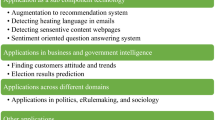Abstract
Social networks are widely used by all kinds of people to express their opinions. Predicting election outcomes is now becoming a compelling research issue. People express themselves spontaneously with respect to the social events in their social networks. Real time prediction on ongoing election events can provide feedback and trend analysis for politicians and news analysts to make informed decisions. This paper proposes an approach to predicting election results by incorporating sub-event detection and sentiment analysis in social networks to analyse as well as visualise political preferences revealed by those social network users. Extensive experiments are conducted to evaluate the performance of our approach based on a real-world Twitter dataset. Our experiments show that the proposed approach can effectively predict the election results over the given baselines.
Access this chapter
Tax calculation will be finalised at checkout
Purchases are for personal use only
Preview
Unable to display preview. Download preview PDF.
Similar content being viewed by others
References
O’Connor, B., Balasubramanyan, R., Routledge, B.R., Smith, N.A.: From tweets to polls: Linking text sentiment to public opinion time series. In: ICWSM, pp. 122–129 (2010)
Tumasjan, A., Sprenger, T.O., Sandner, P.G., Welpe, I.M.: Predicting elections with twitter: What 140 characters reveal about political sentiment. In: ICWSM, pp. 178–185 (2010)
Sang, E.T.K., Bos, J.: Predicting the 2011 dutch senate election results with twitter. In: EACL Workshop on Semantic Analysis in Social Media, pp. 53–60 (2012)
Makazhanov, A., Rafiei, D.: Predicting political preference of twitter users. In: ASONAM, pp. 298–305 (2013)
Jungherr, A., Jurgens, P., Schoen, H.: Why the pirate party won the german election of 2009 or the trouble with predictions: A response to tumasjan, a., sprenger, t. o., sander, p. g., & welpe, i. m. “predicting elections with twitter: What 140 characters reveal about political sentiment”. Soc. Sci. Comput. Rev. 30(2), 229–234 (2012)
Metaxas, P.T., Mustafaraj, E., Gayo-Avello, D.: How (not) to predict elections. In: SocialCom/PASSAT, pp. 165–171 (2011)
Gayo-Avello, D.: I wanted to predict elections with twitter and all i got was this lousy paper - a balanced survey on election prediction using twitter data. CoRR abs/1204.6441, 1–13 (2012)
Abel, F., Hauff, C., Houben, G.J., Stronkman, R., Tao, K.: Semantics + filtering + search = twitcident. exploring information in social web streams. In: HT, pp. 285–294 (2012)
Marcus, A., Bernstein, M.S., Badar, O., Karger, D.R., Madden, S., Miller, R.C.: Twitinfo: aggregating and visualizing microblogs for event exploration. In: CHI, pp. 227–236 (2011)
Meng, X., Wei, F., Liu, X., Zhou, M., Li, S., Wang, H.: Entity-centric topic-oriented opinion summarization in twitter. In: KDD, pp. 379–387 (2012)
Wang, H., Can, D., Kazemzadeh, A., Bar, F., Narayanan, S.: A system for real-time twitter sentiment analysis of 2012 u.s. presidential election cycle. In: ACL (System Demonstrations), pp. 115–120 (2012)
Ringsquandl, M., Petkovic, D.: Analyzing political sentiment on twitter. In: AAAI Spring Symposium: Analyzing Microtext, pp. 40–47 (2013)
Unankard, S., Li, X., Sharaf, M.A.: Emerging event detection in social networks with location sensitivity. World Wide Web, 1–25 (2014)
Jurafsky, D., Martin, J.H.: Speech and Language Processing: An Introduction to Natural Language Processing, Computational Linguistics, and Speech Recognition. Prentice Hall (2000)
Gimpel, K., Schneider, N., O’Connor, B., Das, D., Mills, D., Eisenstein, J., Heilman, M., Yogatama, D., Flanigan, J., Smith, N.A.: Part-of-speech tagging for twitter: Annotation, features, and experiments. In: ACL, pp. 42–47 (2011)
Hu, M., Liu, B.: Mining and summarizing customer reviews. In: KDD, pp. 168–177 (2004)
González-Ibáñez, R., Muresan, S., Wacholder, N.: Identifying sarcasm in twitter: A closer look. In: ACL, pp. 581–586 (2011)
Cochran, W.G.: Sampling techniques. Wiley, New York (1977)
Wilson, T., Wiebe, J., Hoffmann, P.: Recognizing contextual polarity in phrase-level sentiment analysis. In: HLT/EMNLP, pp. 347–354 (2005)
RoyMorgan: Two party preferred voting intention (%)., http://www.roymorgan.com/morganpoll/federal-voting/2pp-voting-intention-recent-2013-2016 (accessed: July 7, 2014)
ReachTel: Two party preferred result based on (2010), election distribution, https://www.reachtel.com.au/blog/7-news-national-poll-5september13 (accessed: July 7, 2014)
NewsPoll: Two party preferred, http://polling.newspoll.com.au.tmp.anchor.net.au/image_uploads/130922 (accessed: July 7, 2014)
Essential: Two party preferred, federal politics – voting intention, http://essentialvision.com.au/documents/essential_report_130905.pdf (accessed: July 7, 2014)
Author information
Authors and Affiliations
Editor information
Editors and Affiliations
Rights and permissions
Copyright information
© 2014 Springer International Publishing Switzerland
About this paper
Cite this paper
Unankard, S., Li, X., Sharaf, M., Zhong, J., Li, X. (2014). Predicting Elections from Social Networks Based on Sub-event Detection and Sentiment Analysis. In: Benatallah, B., Bestavros, A., Manolopoulos, Y., Vakali, A., Zhang, Y. (eds) Web Information Systems Engineering – WISE 2014. WISE 2014. Lecture Notes in Computer Science, vol 8787. Springer, Cham. https://doi.org/10.1007/978-3-319-11746-1_1
Download citation
DOI: https://doi.org/10.1007/978-3-319-11746-1_1
Publisher Name: Springer, Cham
Print ISBN: 978-3-319-11745-4
Online ISBN: 978-3-319-11746-1
eBook Packages: Computer ScienceComputer Science (R0)




